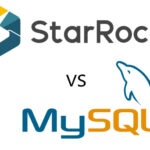In the realm of data management, selecting the right database is crucial for efficient storage, retrieval, and analysis. Three prominent options that stand out are StarRocks DB, MySQL, and PostgreSQL. Each database possesses its own strengths and weaknesses, making it suitable for different use cases. This article delves into the key features and advantages of each database to guide you towards an informed decision.
StarRocks DB: The MPP Analytical Powerhouse
StarRocks DB is an open-source, massively parallel processing (MPP) database designed for large-scale analytical workloads. It excels in handling high-volume, complex queries with low latency, making it ideal for data warehousing and real-time analytics.
Key Advantages of StarRocks DB:
- Unparalleled Performance: StarRocks DB’s distributed architecture and columnar storage enable lightning-fast query execution, even on massive datasets.
- Seamless Scalability: StarRocks DB effortlessly scales horizontally to accommodate growing data volumes and query demands.
- Real-time Analytics: StarRocks DB supports real-time data ingestion and analysis, making it suitable for applications like fraud detection and clickstream analysis.
- Data Format Versatility: StarRocks DB supports a variety of data formats, including Parquet, ORC, and JSON, providing flexibility in data ingestion and analysis.
When to Use StarRocks DB:
- Large-scale data warehousing and analytics
- Real-time data analysis
- Complex ad-hoc queries on massive datasets
MySQL: The Versatile Relational Database
MySQL is a widely used open-source relational database management system (RDBMS) renowned for its simplicity, reliability, and versatility. It’s a popular choice for web applications, transactional systems, and small to medium-sized databases.
Key Advantages of MySQL:
- Ease of Use: MySQL’s user-friendly interface and extensive documentation make it easy to learn and use.
- Maturity and Stability: MySQL has been around for decades and boasts a large community and extensive support resources.
- Scalability: MySQL can scale horizontally to handle increasing workloads.
- Broad Applicability: MySQL is suitable for a wide range of applications, from simple websites to complex e-commerce platforms.
When to Use MySQL:
- Web applications and transactional systems
- Small to medium-sized databases
- Applications requiring simple to moderate data complexity
PostgreSQL: The Feature-Rich Object-Relational Database
PostgreSQL is an open-source object-relational database management system (ORDBMS) acclaimed for its advanced features, data integrity, and compliance capabilities. It’s well-suited for complex applications, data warehousing, and mission-critical systems.
Key Advantages of PostgreSQL:
- Robust Data Integrity: PostgreSQL enforces strong data integrity constraints, making it ideal for critical applications.
- Advanced Feature Set: PostgreSQL offers a wide range of advanced features, including geospatial data support, complex data types, and stored procedures.
- Compliance Adherence: PostgreSQL is compliant with various industry standards and regulations, making it suitable for sensitive data.
When to Use PostgreSQL:
- Complex applications with stringent data integrity requirements
- Data warehousing and analytical applications
- Applications requiring compliance with industry standards
StarRocks DB vs MySQL vs PostgreSQL for Medium-sized Websites
For medium-sized websites with growing data needs, the choice between MySQL and PostgreSQL becomes more nuanced.
MySQL’s simplicity and scalability may still be sufficient for websites with moderate data volumes and query complexity. However, PostgreSQL’s advanced features, data integrity, and compliance capabilities could prove beneficial as websites handle more sensitive data and complex transactions.
StarRocks DB, while powerful, is primarily designed for large-scale data warehousing and analytical workloads. Its complexity and resource requirements make it less suitable for medium-sized websites unless they specifically deal with massive datasets and real-time analytics.
Conclusion
The decision between StarRocks DB, MySQL, and PostgreSQL hinges on the specific needs and requirements of your project. Consider factors such as data volume, query complexity, performance demands, data integrity requirements, and budget when making your choice.
For small websites with simple data needs, MySQL is a strong contender. For medium-sized websites with growing data needs and potential compliance considerations, PostgreSQL offers a robust and feature-rich solution. And for large-scale data warehousing and analytical workloads, StarRocks DB stands out as a powerful and scalable option.
Ultimately, the best database for you is the one that aligns with your project’s specific needs and helps you achieve your data management goals effectively.






Leave a Reply